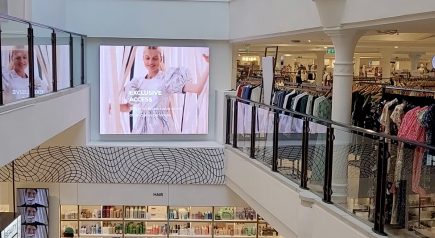CTV OOH: Connected TV Out-of-Home
A distinct format where internet-connected TV screens are placed in public venues (such as bars, restaurants, gyms, airports, and waiting rooms) and used to deliver streaming video ads in conjunction with video content to audiences outside the home environment. The term and practice began to gain industry traction in 2023 as ad tech companies integrated CTV ad delivery with OOH environments, offering new opportunities for brands to reach audiences in public venues.
DOOH (Digital Out-of-Home)
Digital ads displayed on public screens such as digital billboards, transit displays, and kiosks in high-traffic areas.
How Is CTV OOH Used?
Brands use CTV OOH to reach audiences who are away from home in social, dining, and travel settings where they install internet-connected TV screens to stream content and ads. Local businesses also use it to promote in-venue events and specials, often with greater effectiveness than posters or static signage. The most successful CTV OOH campaigns are content-driven, where video ads and content are integrated. Research shows that nearly 90% of people notice content-heavy CTV OOH screens and 64% are more likely to engage with ads when paired with entertainment. This enables owners to avoid displaying an unending parade of ads that may or may not be relevant and instead intersperse content that people want to watch and is customized to the venue.
While CTV OOH may not offer the same level of targeting as in-home CTV, it does allow for geotargeting (e.g., DMA, state, etc.), venue targeting, and content targeting, plus the cost per thousand impressions (CPM) is typically lower than premium TV inventory.
CTV OOH is a Good Investment
CTV OOH creates a “lean-back” viewing experience similar to in-home CTV, but in a social, high-dwell environment where audiences are often more receptive and attentive compared to traditional DOOH placements, which may be more passive or fleeting.
These screens are typically centrally located, and when ads are paired with entertainment content, they are often hard to ignore. Research shows that the large majority of people notice content on these screens, and engagement is higher when ads are paired with relevant programming. CTV OOH also offers marketers the ability to align ads with specific content genres ensuring contextual relevance and reducing the risk of brand safety issues that can arise in some less controlled DOOH environments. This makes it an efficient and effective way to extend an advertiser’s in-home CTV and mobile campaigns into public spaces, creating multiple, reinforcing touchpoints throughout a consumer’s day at home and out in the world, that boost brand recall and conversion rates.
What Else Do We Need To Know?
Reach the Unreachables: Venues like residential lobbies, doctors’ offices, and grocery stores, as well as bars, restaurants, gyms and many others attract desirable, often hard-to-reach demographics (e.g., young adults, sports fans, business travelers). The social context can amplify brand messaging through group viewing and word-of-mouth, which is less common with the more solitary or transient exposure of many DOOH placements.
Expand Reach Beyond the Living Room: CTV OOH brings the power of streaming video ads to public spaces, allowing brands to reach consumers during social outings, travel, or high-dwell moments - contexts where traditional digital ads may not reach.
High Engagement and Noticeability: Video-rich CTV OOH screens capture attention: 89% of people notice them, and engagement is higher when ads are paired with relevant content, making this channel highly effective for brand recall and action.
Cost-Effective Scale: CPMs for CTV OOH are significantly lower than for premium TV spots, making it an attractive option for brands seeking broad reach without the high costs of national TV.
Localized and Contextual Messaging: Brands can tailor ads to specific venues or regions, making campaigns more relevant to local audiences and driving immediate action (e.g., promoting a nearby event or special offer).
Complement Omnichannel Strategies: CTV OOH can be integrated with in-home CTV, mobile, and other OOH campaigns to reinforce messaging and create multiple touchpoints, boosting overall campaign effectiveness and conversion rates.
CTV OOH and DOOH
Feature | CTV OOH | DOOH |
Content Type | Streaming video, live events, entertainment | Static or dynamic digital signage |
Venue | Bars, restaurants, gyms, airports | Billboards, transit, retail, kiosks |
Audience Experience | Social, high-dwell time, group viewing | On-the-go, often brief exposure |
Engagement | High (paired with relevant content) | Moderate (depends on placement) |
Targeting | Contextual (by content/venue), geo-targeting | Contextual (location, time), less granular |
Cost Efficiency | Lower CPM than in-home CTV, premium feel | Can be high relative to CTV |
Brand Safety | High (controlled content environment) | Varies by placement |
In Sum
CTV OOH is now a distinct and fast-emerging advertising genre that blends the strengths of CTV and OOH by delivering engaging, video-rich ads to audiences in public venues. For brand marketers seeking new channels to promote products or services, CTV OOH offers high visibility, strong engagement, cost efficiency, and the ability to complement broader omnichannel strategies-making it a compelling addition to the modern marketing mix.
Growth and Innovation: CTV OOH is poised for rapid growth as more venues adopt connected screens and as ad tech platforms refine targeting and measurement capabilities.
Content Integration: Expect deeper integration of entertainment and branded content to maximize engagement and dwell time.
Programmatic Buying: As with DOOH, programmatic ad buying will streamline access and targeting for CTV OOH inventory.
Measurement Advances: Improved analytics will help marketers better attribute impact, optimize campaigns, and justify increased investment in this emerging channel.










